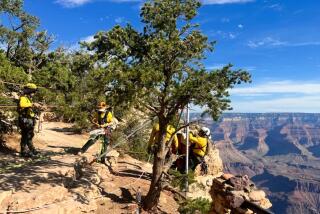Aerial daredevil’s free fall will be stratospheric
- Share via
Teetering 23 miles above the New Mexico desert, Felix Baumgartner plans to leap head first into the abyss and become the first free-falling human to break the sound barrier as he plummets to the ground.
The feat, which will put his life on the line and push his body to the limit, is scheduled to take place shortly after dawn Monday when he falls from 120,000 feet in the air.
JUMP DELAYED:The attempt by Felix Baumgartner to set the world’s free-fall record at 23 miles has been postponed from Monday to Tuesday because of a cold front with gusty winds near Roswell, N.M.
Wearing a newly designed pressurized suit and helmet, the Austria native will test the threshold of his equipment as scientists, aerospace engineers, the Air Force and NASA study what it shows about the limits and capabilities of the human body bailing out from aircraft at ultra-high altitudes.
After several years of preparation and test jumps, Baumgartner, 43, is ready. “I feel like a tiger in a cage waiting to get out,” he said in a statement.
The jump is an effort to break a free-fall world record of more than 19 miles, or 102,800 feet, set by Air Force test pilot Joe Kittinger in 1960. The endeavor, called Stratos, is funded by the energy drink company Red Bull. The company has paid millions of dollars to Southern California aerospace companies to pull it off, but won’t say how much.
Clearly, Red Bull has things in mind besides scientific breakthroughs. The mission involves two dozen cameras, including a helmet cam, to catch the action and to deliver live Web streams. The Austrian company hopes its promotional investment reaps returns on drink sales.
It is a brand that has put its name on extreme-sports athletes competing in such activities as cliff diving and Formula One racing, and it has seen one of its athletes die when skier Shane McConkey was killed in 2009. But this jump is “unprecedented” and risky, said Kelly O’Keefe, a marketing professor at Virginia Commonwealth University.
“This is beyond extreme,” he said. “The risk of failure is so high.”
The company and mission organizers reject talk of the event being done solely for publicity.
“This is a flight test program, not a stunt,” said Art Thompson, technical project director for the mission. “Sure, we’re breaking a 52-year-old record, but we’re developing technology that will benefit humanity for decades to come.”
In addition to testing the new space suit and high-altitude limitations on the human body, Stratos aims to find out whether GPS equipment can function and whether the parachute can provide adequate stabilization.
An engineer who worked for Northrop Corp. on the B-2 stealth bomber in Pico Rivera, Thompson recruited former colleagues from a variety of aerospace backgrounds in Southern California to work on the Stratos mission. Advice came in from local engineers, former astronauts who captained space shuttle missions, and skilled pilots who flew Cold War reconnaissance missions aboard the SR-71 Blackbird.
The Air Force, emphasizing it is not a sponsor of the event, acknowledges that the mission is important to the military.
“The information gathered through biometric data and performance under sustained atmospheric stress may lend lessons to engineering and development of future aircrew flight equipment and escape systems,” said Lt. Col. Andrew Woodrow, a physiology officer at Randolph Air Force Base near San Antonio.
“The Stratos project will potentially provide a basis for future work in human limits at altitude, thermal stress and protective-equipment design,” he said.
Baumgartner will be carried skyward inside a pressurized capsule suspended from the largest balloon ever used in a manned flight. Most of the equipment involved was built by Sage Cheshire Inc., a small aerospace firm in Lancaster founded by Thompson in 2002.
The pressurized capsule, weighing 2,900 pounds — a little more than a Volkswagen beetle — will be carried by a massive, helium-filled ballon to an altitude of 23 miles near Roswell, N.M. The trip will take up to three hours, and temperatures will fall as low as minus 70 degrees.
Once Baumgartner jumps from the capsule about 5 a.m. Pacific time, he’s expected to become supersonic within 35 seconds and ultimately reach about 700 mph.
After free falling an additional five minutes, he will deploy his parachute. About 15 minutes later, Baumgartner should reach the ground. In all, his descent is expected to last 20 minutes.
Without a pressurized suit, Baumgartner’s body fluids would begin to “boil” from lack of atmospheric pressure above 62,000 feet. The suit helps stop nitrogen from forming bubbles in his blood and bringing on decompression sickness, known as the bends.
He will also wear an instrument pack on his chest to monitor heart and respiratory rates and an 8-pound helmet providing oxygen. The helmet will also be outfitted with a radio that keeps him in contact with engineers on the ground. Red Bull has recruited record holder Kittinger to relay messages between mission control and Baumgartner.
Baumgartner, who lives in Switzerland, is an accomplished jumper who has parachuted from a variety of structures, including the Jesus statue in Rio de Janeiro and one of the world’s tallest buildings, Taipei 101 Tower in Taipei, Taiwan.
He has tested the Stratos capsule and balloon twice. In the first test jump, in March, Baumgartner fell from 71,580 feet in Taft, Calif. In his second jump, from 96,640 feet, he free fell for 3 minutes 48 seconds and reached 536 mph.
He safely reached the ground about 10 1/2 minutes after the initial jump. But the capsule needed repairs after the hard landing.
Describing the dangers, Dr. Jonathan Clark, Red Bull Stratos medical director and former NASA flight surgeon, said: “On the ascent, it starts with the potential for balloon failure in the first few thousand feet, when there wouldn’t be enough time for the capsule parachute to deploy or for Felix to bail out. As he gets higher in the atmosphere, low pressure and oxygen deprivation could render him unconscious in seconds if his life-support systems were breached.”
But the mission team is confident about the outcome, he said. “We wouldn’t launch if we didn’t think Felix was ready.”
More to Read
Sign up for Essential California
The most important California stories and recommendations in your inbox every morning.
You may occasionally receive promotional content from the Los Angeles Times.











